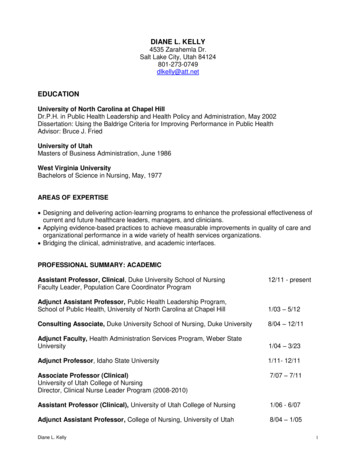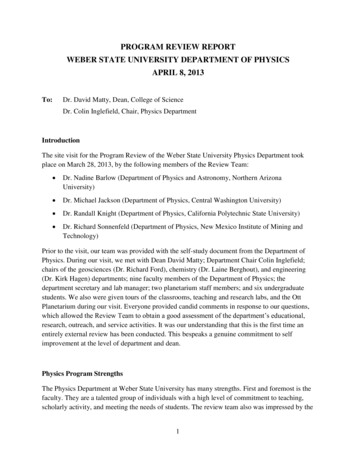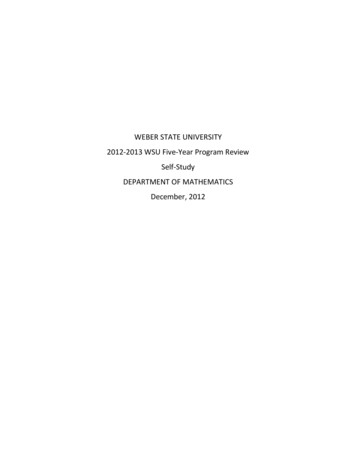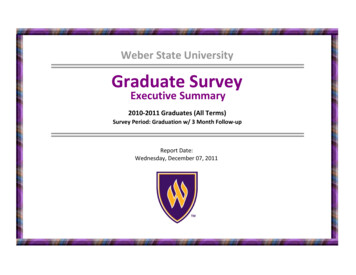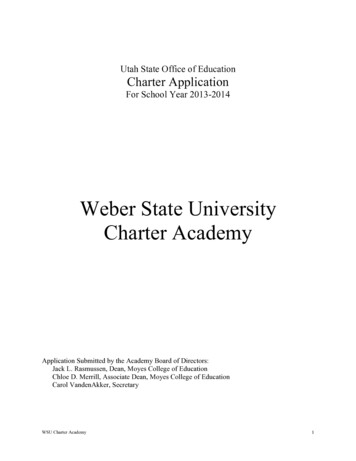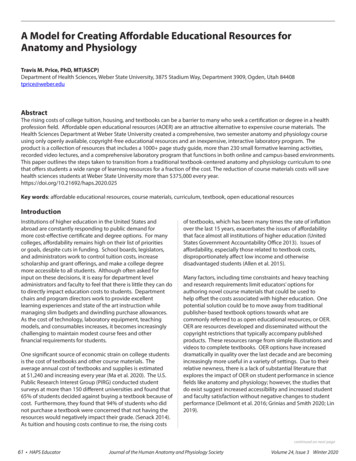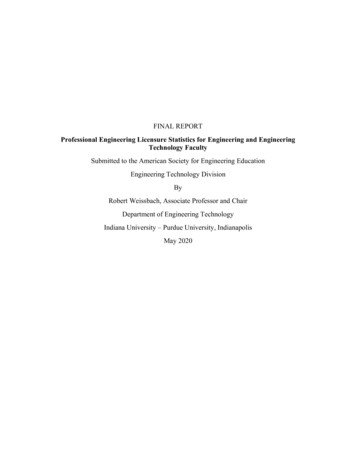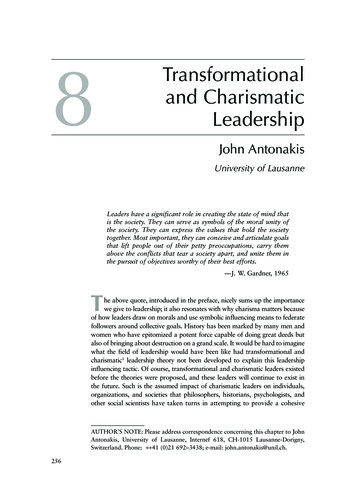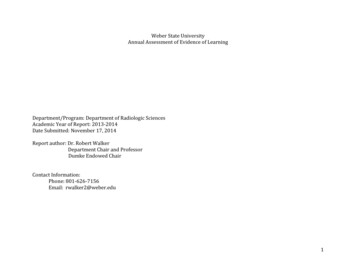
Transcription
Weber State UniversityAnnual Assessment of Evidence of LearningDepartment/Program: Department of Radiologic SciencesAcademic Year of Report: 2013-2014Date Submitted: November 17, 2014Report author: Dr. Robert WalkerDepartment Chair and ProfessorDumke Endowed ChairContact Information:Phone: 801-626-7156Email: rwalker2@weber.edu1
Brief Introductory Statement:The Weber State University Radiologic Sciences Program evolved from two hospital-based radiography programs that wereconducted by St. Benedict’s Hospital and Dee Memorial Hospital. From 1967 to 1970, the hospital-based programs arranged tohave students complete general education courses at Weber State College, while the professional courses were still being taught atthe hospitals. In 1969, the Utah Board of Regents assigned the primary role for radiologic sciences to Weber State College.Beginning autumn quarter in 1970, the hospitals gave up sponsorship of the programs and Weber State College assumedresponsibility of the radiography programs with all classes taught on campus. The first class of Weber State College graduatescompleted the program in the spring of 1973.The Nuclear Medicine and Radiation Therapy programs were approved by the Utah Board of Regents in 1976 and the DiagnosticMedical Sonography Program was approved in 1980. As innovative technological imaging modalities were developed during the1980s, additional programs in Computed Tomography, Magnetic Resonance Imaging, Cardiovascular-Interventional Technology andAdvanced Radiography were added to the program cluster. An emphasis in Mammography was added in the early 1990s. Morerecently the Radiologist Assistant program was developed. Mammography was changed to Women’s Imaging and in 2009 theMasters of Sciences in Radiologic Sciences was approved.During the early 1980s, the Utah Board of Regents approved the baccalaureate degree level in allied health sciences, which allowedthe advanced radiography and the medical imaging specialty areas and radiation therapy to become an educational career ladder fortechnologists. Adding these advanced imaging areas to the program has proven to be beneficial to the medical community byproducing highly-skilled health care workers throughout the state and allows graduates to pursue upward career mobility.Due to campus-wide budget reductions in the mid-80s, the faculty were confronted with the possibility of discontinuing the advancedspeciality modalities. Rather than discontinuing the programs and leaving the medical community without a manpower source, thefaculty, with the permission of the dean and WSU administration, elected to move the programs to the Division of ContinuingEducation. The programs have been self-sustaining programs since that time.Outreach Program:The Weber State College Radiologic Sciences faculty was approached in 1978 to conduct a radiography program in Panguitch, UT inan effort to meet the manpower needs of the rural facility. Students were accepted into the Outreach program beginning autumnsemester of 1979. Soon after, other rural hospitals in the state requested students for their facilities. In 1982, Dixie Medical Centerin St. George and Valley View Hospital in Cedar City were added as clinical sites. The radiography program is designed to move intoan area, educate and train students and when the need is met, the program can be moved to another site. The three main sites forthe program are Price, St. George and Cedar City which provide qualified workers for the southern Utah areas and the Uintah Basinarea. Locations where the radiography program has been conducted in rural areas are as 2
dBeaverPaysonIn addition to the radiography program, Nuclear Medicine, Diagnostic Medical Sonography and Radiation Therapy programs havealso been conducted at various rural sites as need dictates.In an agreement between the faculty and the WSU administration in 1994, students at the St. George, Cedar City and Price, UTsites were included into the campus program as budget-related. The faculty agreed to maintain a minimum of three sites in theoutreach program and the classes are considered as part of the faculty teaching load.In 1992, the Utah State Board of Regents approved a proposal to incorporate clinical sites in surrounding states when WesternWyoming Community College in Rock Springs, WY requested that Weber State University assume responsibility for their radiographyprogram. Permission granted by the Board of Regents allowed several clinical sites to be added. The program operates in the samemanner as the Outreach program, meaning when the need is met, the program can be moved to a different site. The current sitesare as follows:Evanston, WYRawlins, WYJackson Hole, WYDouglas, WYCortez, CODurango, COFarmington, NMMontpelier, IDRiverton, WYTwin Falls, IDIn 1998, Weber State University assumed the management of a hospital-based program in cooperation with Intermountain HealthCare-Utah Valley Regional Medical Center. This program is considered on- campus and budget-related. This is a shared financialagreement between WSU and Intermountain Health Care. The current sites are as follows:Provo, UtahHeber City, UtahOrem, UtahAmerican Fork, UtahThe Department of Radiologic Sciences conducts programs in:RadiographyNuclear MedicineMammographyRadiology AssistantDiagnostic Medical SonographyRadiation TherapyMagnetic Resonance ImagingComputed TomographyAdvanced RadiographyCardiovascular-Interventional Technology3
B. Mission StatementThe mission statement for the Radiologic Sciences Program incorporates the philosophy of the program and is as follows.The mission of the Weber State University Radiologic Sciences Program is to adhere to the mission and goals of the University andthe Dumke College of Health Professions in serving the needsof the medical community and in assisting the students in the development of their potential as technologists and as human beings.Goals stemming from the mission statement are:The primary educational goal of the Radiologic Sciences Program is to use resources to equip students with the knowledge and skillsneeded to live effectively and to provide the knowledge, skills and judgment needed to render quality health care services.A second goal is to broaden the students’ knowledge within the professional discipline and to maintain professional competencythrough a desire to participate in life-long learning.Objectives to assist in attaining the mission and goals are to:1.2.3.4.5.Maintain curricula based on current practices and a competency-based clinical evaluation system.Integrate the didactic and clinical educational components to promote effective learning.Promote a sense of professionalism and a desire to learn through role-modeling, mentoring and teaching practices.Instill an appreciation of racial, cultural and human diversity.Advocate the value of human dignity and ethical conduct.Mission Statement Consistency:The Radiologic Sciences Program mission statement, goals and objectives are integral to the mission statement of Weber StateUniversity (WSU) and the Dumke College of Health Professions. For example, WSU is committed to offering both vocational andprofessional educational programs to prepare students for immediate employment or further study. The Radiologic SciencesProgram cluster is based upon a career ladder concept which provides lateral and/or vertical career mobility; the curriculum isdesigned to introduce new concepts and technological advances in medical imaging and radiation therapy; transmission of valuesand learning in the affective domain are incorporated into the curriculum throughout the program to promote the maintenance ofhuman dignity; critical or analytical thinking and writing are stimulated through classroom interactions, assignments, research andprojects; problem-solving skills are refined in the clinical education setting, in the laboratories, as well as the classroom; students areencouraged to attend professional society meetings, lectures and cultural activities to expand their knowledge; and students aregiven projects which are designed to stimulate life-long education and self-development.4
C. Student Learning OutcomesUpon graduation, students should be able to:1.2.3.4.5.6.7.8.Provide the knowledge, skills and judgment to render quality health care services.Possess a broad knowledge of the professional discipline.Maintain professional competency through life-long learning.Possess knowledge of current practices and demonstrate clinical competency prior to graduation.Apply didactic and clinical knowledge and skills effectively and efficiently.Have acquired a sense of professionalism and a desire to learn.Appreciate racial, cultural and human diversity.Promote the value of human dignity and ethical conduct with regard to patient care.D. CurriculumThe curricula of the programs contain the content required by the national certification agencies. Students must complete all of therequired courses in order to be eligible to sit for the certifying examinations. Courses within a program must be offered each year toenable the class of students currently enrolled to qualify for the national examinations. The following tables provide informationabout each program.Features unique to the Radiologic Sciences Program cluster are the curriculum design which incorporates a selection of corecourses within the upper division advanced radiography curriculum that students entering the advanced imaging programs mustcomplete. This core curriculum efficiently utilizes instructor time and effectively implements the career ladder concept allowingstudents to become multi-skilled health care workers. Other unique features are the ability to offer the programs throughout the ruralareas of the state as need dictates by utilizing an educational delivery system which allows students to remain in their own ruralcommunity while gaining an education; the integration of both the didactic and clinical components of the educational experience thatreinforces learning; and utilization of faculty qualifications and expertise of being certified in more than one imaging modality.The Department of Radiologic Sciences has six (6) courses that have been considered part of general education. Five (5) courseshave be approved for Scientific Inquiry, Radiologic Technology 3443 Quality Assurance in Radiology, Radiologic Technology 4943Baccalaureate Thesis, Radiation Therapy 4446 Quality Assurance, Diagnostic Medical Sonography 4143 Quality Assurance, andNuclear Medicine 4333 Quality Assurance. One Course Radiologic Technology 3003 Psycho-Social Medicine has been approvedfor Diversity Credit.5
OverviewThe curricula of the programs contain the content required by the national certification agencies and meets or exceeds thenational educational standards established by various professional organizations . Students must complete all of therequired courses in order to be eligible to sit for the certifying examinations. Courses within a program must be offeredeach year to enable the class of students currently enrolled to qualify for the national examinations. The following tableprovides information about each program.Table 1ProgramType ofDegreeGeneralCourseEducationRotation byCourses/Maj YearorWSUOnline,DavisCampus,etc.UniqueAspects ofCurriculumRadiographyAAS18-19 cr hrsof gen ed. vs.50 cr hrs inmajor & 25cr hrs ofelectivecoursesUse of ChiTester ande-mail forstudentcommunication;taught atPrice,Cedar City,St. George,Richfield,UintahBasin and4-Cornersarea,Provo IHCCampusAccommodatesstudents whowish a degree orthose who onlywish to becomecertified; allowsstudents toremain in theirrural community;also offered onthe Navajoreservation.68-69 cr hrsrequiredAll coursesmust betaughtannually sostudents willqualify forthecertificationexam6
DiagnosticMedicalSonographyBS42 cr hrs ofgen ed. vs.22 cr hrs inMedicalVascularemphasis &19 in Cardiacemphasiswith 15 cr hrsof supportcourses & 79 in electivecoursesAll coursesmust betaughtannually sostudents willqualify forthecertificationexamUse of ChiTester ande-mail forstudentcommunication; hasbeentaught atSt. George,Cedar City,Gunnison,ProvoAccommodatesstudents whowish to pursue adegree or thosewho only wish tobecome certified;allows studentsto remain in theirrural community;offered on theNavajoreservation.NuclearMedicineBS42 cr hrs ofgen ed. vs.29 cr hrs inmajor & 12 crhrs insupportcoursesAll coursesmust betaughtannuallyUse of ChiTester ande-mail forstudentcommunication; hasbeentaught atPrice, St.George,Vernal,Roosevelt,Provo &Cedar CityAccommodatesstudents whowish to pursue adegree or thosewho only wish tobecome certified;allows studentsto remain in theirrural community.7
RadiationTherapyBS42 cr hrs ofgen ed. vs.36 cr hrs inmajor &12 cr hrs insupportcourses & 12cr hrs ofelectivecoursesAll coursesmust betaughtannuallyUse ofWSUOnline, ChiTester ande-mail forstudentcommunication;taught atProvo, St.Georgeand SaltLake CityAccommodatesstudents whowish to pursue adegree or thosewho only wish tobe come certifiedMagneticResonanceImaging (MRI)BS42 cr hrs ofgen ed. vs.14 cr hrs inmajor & 35 insupportcoursesAll coursesmust betaughtannuallyUse of Chitester & email forcommunication withstudents;taught atVernal,Roosevelt,Cedar City,St. George,Provo andSalt LakeCityAccommodatesstudents whowish to pursue adegree or thosewho only wish tobecome certified8
ComputedTomography(CT)BS42 cr hrs ofgen ed. vs.11 cr hrs inmajor & 35 insupportcoursesAll coursesmust betaughtannuallyUse of ChiTester & email forcommunication withstudents;taught atPrice,Moab,Roosevelt,Vernal,Kanab,Provo andSalt LakeCityAccommodatesstudents whowish to pursue adegree or thosewho only wish tobecome certified9
Curriculum MapTable shows six competencies across the top/ each program down the left side and appropriate courses undereach competency:Table 2SIX departmentalcompetencies usedfor directmeasurements oflearning in ALLprograms in theDepartmentPatientCare andEducationProfessionalDevelopment andResearchBiologicEffects andSafetyClinicalCompetencyand MedicalEthicsProcedures,Anatomy andPathophysiologyInstrumentation and QualityControlAssociate of Applied ScienceRadiographyRADT 2992SeminarRADT 2833RADT 3043RADT 28612865RADT 1502-1532 RADT 1303RADT 2403RADT 2942RADT 2913RADT 2865RADT 1601-1661 RADT 2403RADT 3003RADT 2803RADT 2913RADT 2272RADT 3443RADT 2913RADT 2913RADT 3043RADT 2913RADT 3463RADT 2913RADT 3463Bachelor's of Science10
AdvanceRadiographyRADT 3003RADT 4213RADT 3403RADT 3043RADT 3123RADT 3443RADT 3263RADT 4233RADT 3423RADT 3863RADT 3143RADT 3463RADT 3523RADT 3563RADT 4303RADT 4433RADT 4203RADT 4443CardiovascularInterventionalRADT4203RADT 4933RADTDV3003RADT 4943RADT 3123RADT 3863RADT3143RADT 3263RADT 4863RADT 4313RADT 3253RADT 3043RADT 4343Note--these wereobtain in theradiographyprogramRADT 3563RADT 4303RADT 4333RADT 4913ComputedTomographyRADTDV3003RADT 4933RADT 3403RADT 3043RADT 3123RADT 356311
RADT 3253RADT 4943RADT 4203RADT 3863RADT 3143RADT 4863RADT 4613RADT 4663RADT 4303RADT 4911DMS MedicalRADT 3003RADT 4933RADT 3043DMS 4610RADT 3123DMS 4110RADT 3243RADT 4943DMS 4110DMS 4811RADT 3143DMS 4120RADT 3253DMS 4801DMS 4120DMS 4812DMS 4210DMS 4912DMS 4813DMS 4220DMS 4310DMS 4330DMS 4340DMS CardiacRADT 3003RADT 4933RADT 3043DMS 4620RADT 3123DMS 4110RADT 3243RADT 4943DMS 4110DMS 4821RADT 3143DMS 4120RADT 3253DMS 4801DMS 4120DMS 4822DMS 4310DMS 4911DMS 4823DMS 4230DMS 4813DMS 422012
DMS 4210DMS VascularMRIDMS 4630,4410. 4420DMS 4630,4110DMS 4831,4832DMS 4410,4420DMS 4110RADT 3003RADT 4933RADT 3043DMS 4630RADT 3123DMS 4120RADT 3243RADT 4943DMS 4110DMS 4831RADT 3143DMS 4913RADT 3253DMS 4801DMS 4120DMS 4832DMS 4410DMS 4833DMS 4420RADT 3043RADT 3123RADT 3563RADT 3863RADT 3143RADT 4603RADT 4863RADT4643RADT DV3003RADT 4933RADT 3253RADT 4943RADT 4623RADT 4203RADT 4633RADT 4303RADT 4912Nuclear MedicineRADT 3243RADT 4933RADT 3043NUCM4861RADT 3143RADT 3563RADT 3263RADT 4943RADT 3423NUCM 4862NUCM 4103NUCM 4303NUCM 4863RADT 4303MUCM 4333NUCM 420313
NUCM 4213NUCM 4223NUCM 4912RARADT 3243RADT 4992RADT 3403RADT 3043RADT 3123RADT SI 3443RADT 3253RADT 4933RADT 4253RADT 5861RADT 3143RADT 3563RADT 3263RADTSI 4943RADT 5862RADT 3144RADT 4203RADT 5863RADT 3145RADT DV3003RADT 5864RADT 3146RADT 5865RADT 3147RADT 5868RADT 3148RADT 3149RADT 3150RADT 3151RADT 3152RADT 3153Radiation TherapyRADT 4992RADT 4933RATH 4330RADT 3563RATH 4410RATH SI4446RATH 4448RADT 3403RATH 4861RATH 4412RATH 434214
RADT 4943RATH 4862RATH 4414RATH 4444RATH 4863RATH 4913RADT 3861RADT 4553,4563RADT 4583,4563Women's Imaging--MammographyRADT 4563RADT 4563--Bone DensityRADT 4543RADT 4543RADT 4543RADT 4543DMS 4110DMS 4510DMS 4110--Breast Sonography DMS 4510The above grid was utilized for all direct measures of learning. All courses are step lock curriculum and were pre and posttested utilizing CHI tester in each of the six measures. All students will complete the pre and post testing each semester ineach of the 6 categories. The comprehensive posttest each semester will become the pretest for the next semester.Each Student should score 70% or higher on the comprehensive posttest each semester. All students for the purposes ofNational Certification and/or State licensure must reach a 75% cut score to enter the work force in each of the six contentareas listed below:Patient Care and EducationProfessional Development and ResearchBiologic Effects and SafetyClinical Competency and Medical EthicsProcedures, Anatomy and PathophysiologyInstrumentation and Quality Control15
E. Assessment PlanAdditionally all courses of study will be evaluated using the following grid which is appropriate for benchmarking with otherprograms in the Radiologic Sciences.Radiography ProgramObjectiveInternal MeasurementExternal MeasurementData CollectionUpon completing the Radiography Program the student will be able to;Identify the biological effects ofradiation.Successful Completion of: Radtec1303; 34031. Utah State Practical Technicianresults Examination2. ARRT Examination results3. Clinical Evaluation & Personal& Professional GrowthAssessment1. Annually2. Annually3.Every semesterDemonstrate proper radiationprotection procedures duringdiagnostic procedures.Successful Completion of:Radtec 1022; 3403; 1502/1601;1512/1621; 1522/1641;1532/1661; 1542/1681Clinical Evaluations: Radtec 286128651. Utah State Practical Technicianresults Examination2. ARRT Examination results3. Clinical Evaluation & Personal& Professional GrowthAssessment1. Annually2. Annually3. Every semesterDemonstrate proper use andunderstanding of radiationexposure monitors and diagnosticradiation equipment.Successful Completion of:Radtec 1303, 2403, 3443;1502/1601; 1512/1621;1522/1641; 1532/1661; 1542/1681Clinical Evaluations:Radtec 2861-28651. Utah State Practical Technicianresults Examination2. ARRT Examination results3. Clinical Evaluation & Personal& Professional GrowthAssessment1. Annually2. Annually3. Every semesterDemonstrate, select, accuratelyexplain and produce diagnosticquality radiographs.Successful Completion of:Radtec 1303; 2403; 3443;1502/1601; 1512/1621;1522/1641; 1532/1661; 1542/1681Clinical Evaluations:Radtec 2861-28651. Utah State Practical Technicianresults Examination2. ARRT Examination results3. Employer Surveys4. Clinical Evaluation & Personal& Professional GrowthAssessment1. Annually2. Annually3. Every 3 years (next 2008)4. Every semester16
Demonstrate repeatedcompetency in accuratelyexplaining the proper radiographicfilm processing technique.Successful Completion of:Radtec 1303; 2403; 3443;1502/1601; 1512/1621;1522/1641; 1532/1661; 1542/1681Clinical Evaluations: Radtec 286128651. Utah State Practical Technicianresults Examination2. ARRT Examination results3. Job placement rates4. Employer Surveys5. Clinical Evaluation & Personal& Professional GrowthAssessment1. Annually2. Annually3. Annually4. Every 3 years (next 2008)5. Every semesterDemonstrate and accuratelySuccessful Completion of:interpret quality assurance testing. Radtec 1303; 2403; 3443;1542/1681 Clinical Evaluations:Radtec 2861-28651. Utah State Practical Technicianresults Examination2. ARRT Examination results3. Clinical Evaluation & Personal& Professional GrowthAssessment1. Annually2. Annually3. Every semesterDemonstrate proper evaluationand critique of radiographicpositioning, technical factors,anatomy, physiology andpathology.Successful Completion of:Radtec 1502/1601; 1512/1621;1522/1641; 1532/1661;1542/1681;Clinical Evaluations:Radtec 2861-28651. Utah State Practical Technicianresults Examination2. ARRT Examination results3. Clinical Evaluation & Personal& Professional GrowthAssessment1. Annually2. Annually3. Every semesterDemonstrate legal andprofessional responsibility.Successful Completion of:Radtec 3003; 3403; 2043; 3423;1022Clinical Evaluations: Radtec 286128651. Utah State Practical Technicianresults Examination2. ARRT Examination results3. Clinical Evaluation & Personal& Professional GrowthAssessment1. Annually2. Annually3. Every semesterDemonstrate appropriate patienteducation, safety and comfortskills.Successful Completion of:Radtec 1022; 2043; 3003; 2263;1502/1601; 1512/1621;1522/1641; 1532/1661;1542/1681;Clinical Evaluations:Radtec 2861-28651. Utah State Practical Technicianresults Examination2. ARRT Examination results3. Clinical Evaluation & Personal& Professional GrowthAssessment1. Annually2. Annually3. Every semesterDemonstrate acceptable methods Successful Completion of:1. Utah State Practical Technicianof infection control and prevention. Radtec 1022; 2043; 3003; 2263;results Examination1502/1601; 15121621; 1522/1641; 2. ARRT Examination results1. Annually2. Annually3. Every semester17
1532/1661; 1542/16813. Clinical Evaluation & PersonalClinical Evaluations: Radtec 2861- & Professional Growth2865AssessmentDemonstrate proper patientmonitoring during radiographicprocedures.Successful Completion of:Radtec 2043; 3003; 2263Clinical Evaluations:Radtec 2861-28651. Utah State Practical Technicianresults Examination2. ARRT Examination results3. Clinical Evaluation & Personal& Professional GrowthAssessment1. Annually2. Annually3. Every semesterDemonstrate appropriateresponses to diverse patientpopulations.Successful Completion of:Radtec 3003; 3023 ClinicalEvaluations: Radtec 2861-28651. Utah State Practical Technicianresults Examination2. ARRT Examination results3. Clinical Evaluation & Personal& Professional GrowthAssessment4. Employer Surveys5. Graduate Surveys1. Annually2. Annually3. Annually4. Every 3 years (next 2008)5. Every 3 years (next 2008)Demonstrate a sense ofprofessionalism and desire tolearn.Successful Completion of:Radtec 1022; 3003; 28661. Utah State Practical Technicianresults Examination2. ARRT Examination results3. Employer Surveys4. Graduate Surveys5. Exit interviews6. Clinical Evaluation & Personal& Professional GrowthAssessment1. Annually2. Annually3. Every 3 years (next 2008)4. Every 3 years (next 2008)5. Annually6. Every semester1. Employer Surveys2. Graduate Surveys3. Exit Interviews4. Clinical Evaluation & Personal& Professional GrowthAssessment1. Every 3 years (next 2008)2. Every 3 years (next 2008)3. Annually4. Every semesterStudent acceptance into specialtyprogramsDemonstrate continuedcompetency through life longlearning.Student acceptance into specialtyprogramsAdvanced Radiography, Imaging Specialties and Radiation Therapy18
ObjectiveInternal MeasurementExternal MeasurementData CollectionUpon completing the Advanced Radiography, Imaging Specialties & Radiation Therapy Program, the student will be able to;Identify the biologic effects ofionizing radiation.Successful Completion of:RT 3403, 3443Certification examination resultsAnnuallyDemonstrate proper radiationprotection procedures duringdiagnostic procedures.Successful completion of:1. Certification examination results 1. AnnuallyRT 4863 – CT;2. Employer Surveys2. Every 3 Years (next 2008)RT 4861&4862 – MammoRT 5861, 5862, 5863, 5864 & 5865– RPANM 4861, 4862, 4863RTH 4861, 4862, 4863Demonstrate patient assessment, Successful completion of: RT 3243 1. Certification examination results 1. Annuallymonitoring and management skills. & RT 32532. Employer Surveys2. Every 3 Years (next 2008)RT 3263, RT 4303RT 5363 & 4423 -- RPARTH 4425– Rad TherapyClinical evaluationsDemonstrate appropriate patienteducation, safety and comfortskills.Successful completion of:RT 3003, RT 3043RT 4203, RT 4223RT 4572-- MammographyRTH 4425– Rad TherapyClinical evaluations1. Certification examination results 1. Annually2. Employer Surveys2. Every 3 Years (next 2008)Demonstrate legal, professionaland ethical responsibility.Successful completion of:RT 3003, RT 3043RT 4253, RT 4233Clinical evaluationsCertification examination resultsDemonstrate knowledge ofanatomy, physiology andpathophysiologySuccessful completion of:RT 3023, RT 31231. Certification examination results 1. Annually2. Employer surveys2. Every 3 years (next 2008)Demonstrate appropriateresponses to diverse patientpopulationsSuccessful completion of:RT 3003, RT 4203, RT 3243RT 3253, RT 5363Clinical evaluations1. Certification examination results 1. Annually2. Employer surveys2. Every 3 years (next 2008)3. Graduate surveys3. Every 3 years (next 2008)Demonstrate knowledge andapplication of federal regulationsSuccessful completion of:RT 3043, RT 34231. Certification examination results 1. Annually2. Employer surveys2. Every 3 years (next 2008)Annually19
RT 4243, RT 4253RT 4213Clinical evaluationsDemonstrate a sense ofSuccessful completion of:professionalism and desire to learn RT 4803, RT 4933RT 4943, RT 4922,RT 4942, RT 4992Active participation in professionalorganizations; acceptance intograduate programs1. Exit interviews2. Graduate surveys3. Employer surveys1. Annually2. Every 3 years (next 2008)3. Every 3 years (next 2008)Demonstrate continuedcompetency through life longlearning1. Maintenance of activecertification status2. Employer surveys3. Employment rate4. Graduate surveys1. Every 3 years (next 2008)2. Every 3 years (next 2008)3. Every 3 years (next 2008)4. Every 3 years (next 2008)Active participation in professionalorganizationsAcceptance into graduate schoolComputerized Tomography/Magnetic Resonance Imaging (CT/MRI)ObjectiveInternal MeasurementExternal MeasurementData CollectionUpon completing the Computerized Tomography/Magnetic Resonance Imaging Program, the student will be able to;Demonstrate proper use of imaging Successful Completion of:equipment.RT 4603, RT 4623, RT 4663, RT3463Clinical evaluations:RT 48631. Certification examination results 1. Annually2. Employer surveys2. Every 3 years (next 2008)3. Graduate surveys3. Every 3 years (next 2008)Demonstrate proper selection oftechnical factors to producediagnostic imaging.Successful completion of:RT 4633, RT 4643RT 4613, RT 4653RT 4911, RT 4912Clinical evaluations:1. Certification examination results 1. Annually2. Employment rate2. Annually3. Graduate surveys3. Every 3 Years (next 2008)Demonstrate and accuratelySuccessful completion of:interpret quality assurance testing. RT 3443, RT 4603RT 4663Clinical evaluations:1. Certification examination results 1. Annually2. Employer surveys2. Every 3 Years (next 2008)20
Demonstrate proper evaluation andcritique of diagnostic images foraccuracy of technical factors,patient positioning, anatomy,contrast injection and pathology.Successful completion of:RT 4633, RT 4643RT 4613, RT 4653RT 4623, RT 4911 and RT49121. Certification examination results2. Employer surveys3. Employment rate4. Graduate surveys1. Annually2. Every 3 Years (next 2008)3. Annually4. Every 3 Years (next 2008)Cardiovascular-Interventional Technology (CVIT)ObjectiveInternal MeasurementExternal MeasurementData CollectionUpon completing the Cardiovascular-Interventional Technology Program, the student will be able to;Demonstrate proper use of imaging Successful Completion of:equipment.RT 3463, RT 4913,ARRT certificationClinical evaluations:RT 48631. Certification examination results 1. Annually2. Employment rates2. AnnuallyDemonstrate proper use oftechnical factors to producediagnostic images.Successful completion of:RT 4313, RT 4333,RT 4343Clinical evaluations:Certification examination resultsAnnuallyDemonstrate and accuratelySuccessful completion of:interpret quality assurance testing. RT 3443, RT 3463ARRT certificationClinical evaluations:Certification examination resultsAnnuallyDemonstrate proper evaluation and Successful completion of:critique of diagnostic images forRT 4313, RT 4333accuracy of technical factors,and RT4343patient positioning, anatomy,contrast injection and pathology.1. Certification examination results 1. Annually2. Employment rate2. Annually3. Employer surveys3. Every 3 Years (next 2008)MammographyObjectiveInternal MeasurementExternal MeasurementData CollectionUpon completing the Mammography Program, the student will be able to;21
Demonstrate proper use of imaging Successful Completion of:equipmentRT 4563Clinical evaluations:RT 4861, RT 48621. Certification examination results 1. Annually2. Employment rate2. Annually3. Employer surveys3. Every 3 Years (next 2008)Demonstrate proper selection oftechnical factors to producediagnostic imagesSuccessful Completion of:RT 4553, RT 4563Clinical evaluations:RT 4861, RT 48621. Certification examination results 1. Annually2. Employment rate2. Annually3. Employer surveys3. Every 3 Years (next 2008)Demonstrate and accuratelySuccessful completion of:interpret quality assurance testing. RT 4583Clinical evaluations:RT 4861, RT 48621. Certification examination results 1. Annually2. Employer surveys2. Every 3 Years (next 2008)Demonstrate proper evaluation andcritique of diagnostic images foraccuracy of technical factors,patient positioning, anatomy,contrast injection and pathology.1. Certification examination results 1. Annually2. Employer surveys2. Every 3 Years (next 2008)3. Employment
Courses/Maj or Course Rotation by Year WSU Online, Davis Campus, etc. Unique Aspects of Curriculum Radiography AAS 18-19 cr hrs of gen ed. vs. 50 cr hrs in major & 25 cr hrs of elective courses 68-69 cr hrs required All courses must be taught annually so students will qualify for the certification exam Use of Chi Tester and e-mail for student


